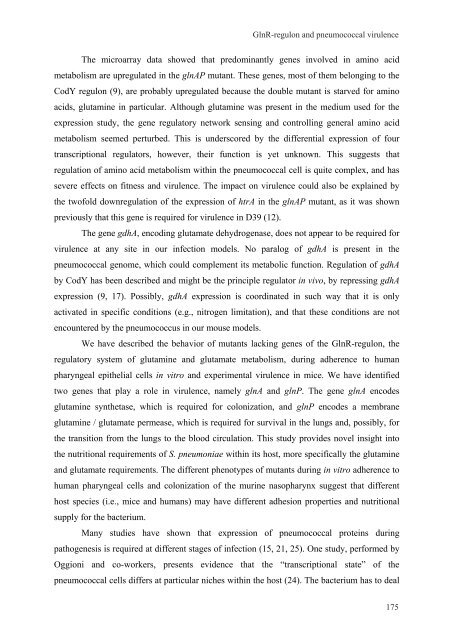Gene regulation in Streptococcus pneumoniae - RePub - Erasmus ...
Gene regulation in Streptococcus pneumoniae - RePub - Erasmus ...
Gene regulation in Streptococcus pneumoniae - RePub - Erasmus ...
Create successful ePaper yourself
Turn your PDF publications into a flip-book with our unique Google optimized e-Paper software.
The microarray data showed that predom<strong>in</strong>antly genes <strong>in</strong>volved <strong>in</strong> am<strong>in</strong>o acid<br />
metabolism are upregulated <strong>in</strong> the glnAP mutant. These genes, most of them belong<strong>in</strong>g to the<br />
CodY regulon (9), are probably upregulated because the double mutant is starved for am<strong>in</strong>o<br />
acids, glutam<strong>in</strong>e <strong>in</strong> particular. Although glutam<strong>in</strong>e was present <strong>in</strong> the medium used for the<br />
expression study, the gene regulatory network sens<strong>in</strong>g and controll<strong>in</strong>g general am<strong>in</strong>o acid<br />
metabolism seemed perturbed. This is underscored by the differential expression of four<br />
transcriptional regulators, however, their function is yet unknown. This suggests that<br />
<strong>regulation</strong> of am<strong>in</strong>o acid metabolism with<strong>in</strong> the pneumococcal cell is quite complex, and has<br />
severe effects on fitness and virulence. The impact on virulence could also be expla<strong>in</strong>ed by<br />
the twofold down<strong>regulation</strong> of the expression of htrA <strong>in</strong> the glnAP mutant, as it was shown<br />
previously that this gene is required for virulence <strong>in</strong> D39 (12).<br />
The gene gdhA, encod<strong>in</strong>g glutamate dehydrogenase, does not appear to be required for<br />
virulence at any site <strong>in</strong> our <strong>in</strong>fection models. No paralog of gdhA is present <strong>in</strong> the<br />
pneumococcal genome, which could complement its metabolic function. Regulation of gdhA<br />
by CodY has been described and might be the pr<strong>in</strong>ciple regulator <strong>in</strong> vivo, by repress<strong>in</strong>g gdhA<br />
expression (9, 17). Possibly, gdhA expression is coord<strong>in</strong>ated <strong>in</strong> such way that it is only<br />
activated <strong>in</strong> specific conditions (e.g., nitrogen limitation), and that these conditions are not<br />
encountered by the pneumococcus <strong>in</strong> our mouse models.<br />
We have described the behavior of mutants lack<strong>in</strong>g genes of the GlnR-regulon, the<br />
regulatory system of glutam<strong>in</strong>e and glutamate metabolism, dur<strong>in</strong>g adherence to human<br />
pharyngeal epithelial cells <strong>in</strong> vitro and experimental virulence <strong>in</strong> mice. We have identified<br />
two genes that play a role <strong>in</strong> virulence, namely glnA and glnP. The gene glnA encodes<br />
glutam<strong>in</strong>e synthetase, which is required for colonization, and glnP encodes a membrane<br />
glutam<strong>in</strong>e / glutamate permease, which is required for survival <strong>in</strong> the lungs and, possibly, for<br />
the transition from the lungs to the blood circulation. This study provides novel <strong>in</strong>sight <strong>in</strong>to<br />
the nutritional requirements of S. <strong>pneumoniae</strong> with<strong>in</strong> its host, more specifically the glutam<strong>in</strong>e<br />
and glutamate requirements. The different phenotypes of mutants dur<strong>in</strong>g <strong>in</strong> vitro adherence to<br />
human pharyngeal cells and colonization of the mur<strong>in</strong>e nasopharynx suggest that different<br />
host species (i.e., mice and humans) may have different adhesion properties and nutritional<br />
supply for the bacterium.<br />
GlnR-regulon and pneumococcal virulence<br />
Many studies have shown that expression of pneumococcal prote<strong>in</strong>s dur<strong>in</strong>g<br />
pathogenesis is required at different stages of <strong>in</strong>fection (15, 21, 25). One study, performed by<br />
Oggioni and co-workers, presents evidence that the “transcriptional state” of the<br />
pneumococcal cells differs at particular niches with<strong>in</strong> the host (24). The bacterium has to deal<br />
175<br />
175

















